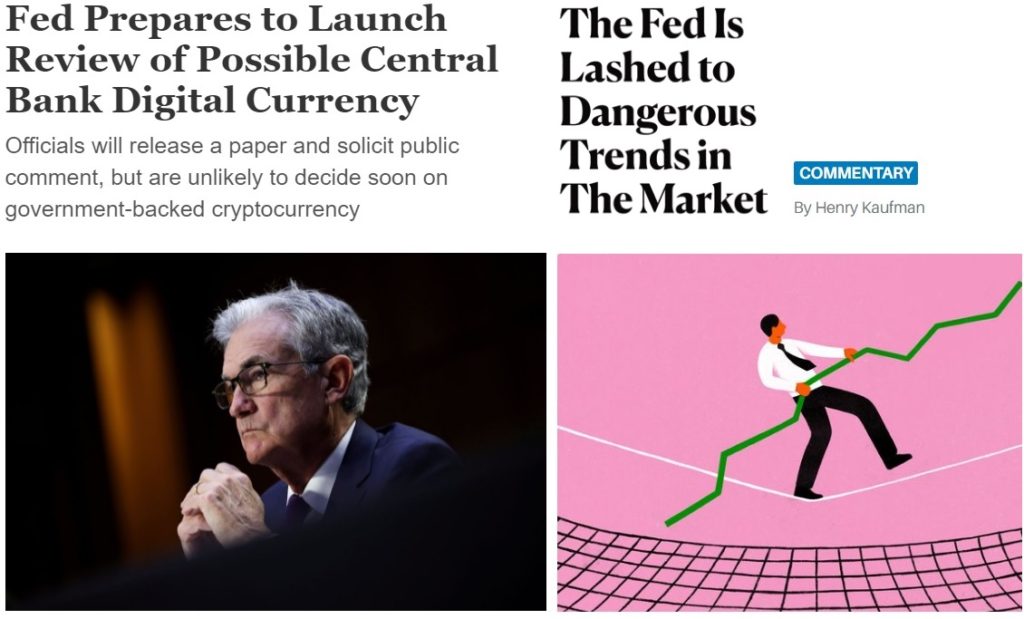In recent weeks, a piece of news and a piece of commentary, which we show you below, crossed our desk — items which were interesting enough taken in isolation, but which became even more interesting when taken together.

Source: Wall Street Journal, Barrons
The first was a report about the Fed’s moves towards the possible implementation of a central bank digital currency for the U.S. — a “digital dollar.” Of course this move has been in the works for a long time, and we have been discussing it for years. The Fed’s language is cautious, but from our perspective, the writing is on the wall that some form of an official U.S. digital currency is coming.
The second was a brief note by financial éminence grise Henry Kaufman, who has been offering critical commentary on market dynamics and regulatory developments (or the lack of them) for many decades. His sobriquet, “Dr Doom,” speaks to his not-entirely-deserved reputation for permanent bearishness. Kaufman, who will celebrate his 94th birthday in a few weeks, had deep insights into the causes of the Dotcom Crash and the Great Financial Crisis, though in the end, his insights and warnings have not been heeded. His recent note sounded some of the same warnings we heard from him in 1998 and in 2007.
There are obvious connections between Kaufman’s observations about the current state of markets and the Fed’s influence, on the one hand, and the Fed’s preparation — as belated as any of its preparations have ever been — to dip its toes into the new financial universe of digital assets, on the other.
Since the late 1990s, Kaufman has been making a simple point, which we know well, and which indeed is a point learned quickly on anyone’s first day on a trading desk. After performing due fundamental diligence to understand a security’s value, an investor wants to know above all about liquidity conditions, and about the real marketability of that security in the quantities in which s/he wants to buy or sell it. Otherwise, the valuation of that security and the portfolio containing it is simply a fantasy — or an arbitrary mathematical construction.
Changes in financial markets over the decades have fundamentally transformed realities of liquidity and marketability, probably ultimately as a result of the collapse of Bretton Woods and the final demise of the gold standard — of which we are “celebrating” the 50th anniversary this year. That shift ushered in a gradual and profound expansion of the financial system; the birth of a bewildering array of non-bank financial actors and entities; an ongoing ballooning of debt for consumers, corporates, and governments; and an ever-increasing profusion of securitized financial products. The rise of the digital asset universe is simply the love-child of this freewheeling expansion, and the internet.
The Lender of Last Resort
The vast expansion of credit creation has led to a fundamental shift: where liquidity used to mean cash and highly marketable securities, it gradually came to mean access to credit — and access to credit depends, of course, on the willingness of the creditor to extend it. That reliance on credit, as it has grown, has therefore introduced a more pervasive risk into market structure — since that kind of “liquidity” is much more disposed to simply evaporate should creditors determine that conditions are too risky. (Consider this: these days, when companies defend their “liquidity” to analysts and investors, they refer to their ability to borrow, not to cash and marketable securities on hand.)
Crises of contagious risk aversion and liquidity destruction therefore become even more of a specter than they had been in the past. Hence the inexorable rise of the need for a lender of last resort. That process has been underway for 50 years, but it seemed to reach a new peak of speed and intensity last year during the pandemic crash.
Notably, the transformation of “liquidity” into “access to credit” explicitly sets the stage for more and more severe volatility in financial markets, given the sudden changes in credit conditions that can be precipitated by changes in market sentiment. Here again, the “lender of last resort” becomes an existential need.
The Buyer of Last Resort
A parallel change has occurred with the notion of marketability. Securitization — which includes the extremely significant rise of passive index funds for stocks and bonds — gives an illusion of marketability for securitized instruments. Under stressful conditions, the actual underlying stocks, bonds, options, or other securities might not have enough buyers to match to would-be sellers. In short, thanks to financial creativity and deregulation, there may be a lot of instruments out there whose marketability investors assume… but which, in a crisis, would prove to be an illusion. In a 1998 Boston Fed conference, Kaufman commented:
“What may make a good deal of sense to an individual investor or a single institution — that is, to avoid the risk of underperformance by settling for the average return of a market index — collectively increases the probability that market values will lurch from one extreme to another.”
The two decades since, we think, have begun to prove him right.
Have these new instruments created benefits for investors? Absolutely. Have they also produced novel sources of systemic risk? Without a doubt.
We might say, looking back on the whole era of QE, and the venture of some national banks (such as the Bank of Japan) into equity buying, that this marketability risk has created the need for a buyer of last resort of all kinds of financial instruments.
(As a side-note, this is why at Guild we don’t use margin, and we invest only in marketable securities for which a liquid market exists — and why we consider company managements’ balance-sheet behavior carefully in evaluating a potential addition to our clients’ portfolios.)
The “Unwilling” Fed
Who, then, is there to serve as the lender of last resort, and the buyer of last resort? Increasingly, fatefully, the answer has been “the Federal Reserve.” As an institution, the Fed may not have really wanted this role, even if individual Fed officials sometimes exulted in it — but it has been forced on it as a result of decisions made by the Fed itself and by the U.S. government. Within the fiat framework, the only other option would be to let the system function with a volatility that would become increasingly destructive to Americans in the middle — everyone from small business owners to professionals — and to the working poor.
In brief, by its policies and its neglect, the Fed created the current financial landscape and the risks that stalk it. Now it “owns” those risks.

This is why the Fed will have no choice but to enter the digital arena. Here, as it always has, it is playing catch-up with trends that it did not think merited regulatory attention for decades — if it even noticed them at all while it was creating them or enabling them.
Digital assets take the same trends of transforming liquidity and marketability and raise them to the power of ten — or a thousand. With tokenized securities, DeFi, smart contracts, distributed marketplaces, and the like, there will soon be — whether regulators like it or not — 24/7/365 trading markets in everything from stocks, to bonds, to arcane options, to fractional ownership of collectibles and real estate, to NFTs (nonfungible tokens — a piece of technological madness which despite our best efforts, we have thus far been unable to rationally comprehend).
As individuals, corporates, and governments increasingly are exposed to and reliant on these new, digitally securitized markets, they will become increasingly exposed to the same destabilizing trends that have bedeviled non-digital markets in the post-Bretton Woods era. As “smart” as digital securities may be said to be, trust us — they are not smart enough to avoid the pitfalls of illusory liquidity and marketability discussed above. We will find that digital asset markets can are also susceptible to freezing and crashing — maybe more so, given the sparse presence of humans making deliberate real-time, face-to-face decisions.
Bitcoin and other cryptos are in many ways a direct reaction to the poor management of the economy and the financial system in the fiat era that has followed the gold standard. We note this year that gold has performed poorly compared to cryptos, and we note further that in the correction that has been unfolding deep in the U.S. indices since May, increasingly, cryptos are rallying when stocks are challenged. To us this signals that the shift is underway whereby cryptos are slowly becoming the preferred means for investors and speculators to express their skepticism about government’s capacity to manage the economy, the currency, and the stability of markets. There is still a place for precious metals in portfolios, to be sure, but the shift to cryptos is becoming undeniable.
What effect will the Fed’s foray into digital assets have? Sadly, we are not optimistic that it will be beneficial for investors overall, given the “human, all too human” nature of the people running it — of which recent revelations and departures of regional Fed chairs are an example.
Perceptive and free-thinking investors will, as always, be able to find areas benefitted even by inept Fed policy. Unfortunately, digital central bank currencies, we believe, are likely to be captured and employed to further the plans of overreaching governments — witness the recent power-grab which would compel banks to surveil their account holders’ transactions down to $600 on behalf of the IRS. A digital currency, while it could be used to quell turmoil in the systemically important digital asset markets of the future, would also present governments with the temptation for overweening control — a temptation that history, sadly, suggests they would be unable and unwilling to resist.
Investment implications: The Fed is both the co-creator and the victim of monetary and economic trends that its own policies, over the decades, have created or simply failed to address. The fundamental issues that have arisen since the end of the gold standard continue to exacerbate and conceal the systemic rise of risk — particularly of market dislocations in the event of a shock. The Fed has increasingly taken over the role of an ultimate backstop against such market dislocations, in order to mitigate damage to the real economy. The Fed has also taken over the role of “policy backstop” — much of the currently prominent environmental and social agenda would be inconceivable without the Fed’s facilitation.
With the prospect of much financial activity migrating into the universe of digital assets in coming years, the Fed is finally investigating the creation of its own digital currency. We can bet that the Fed will be behind the curve here as it has been with all financial innovations.
Still, this is the environment within which investors must act; if investors want to protect their wealth from the corrosive effect of inflation, sitting on the sidelines as a permanent bear is foolish. The Fed has painted itself into a corner, and no future choice will curtail its role — it will take an “accident.” Should such an accident occur, investors will be grateful that they paid attention to issues of liquidity and marketability in constructing their portfolios.


